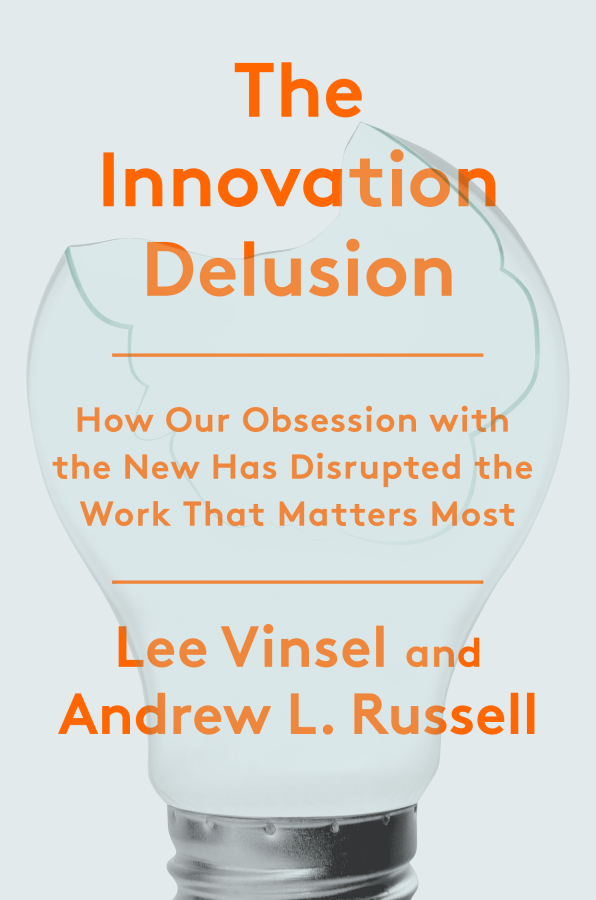For as long as it has existed, people have been trying to replicate the magic of Silicon Valley, to capture some of its ineffable ability to produce true innovation—inventions that have changed many people’s lives for the better. But despite its real claim to innovation, Silicon Valley has also come to represent something less tangible. Andrew Russell, professor of history and dean of the College of Arts and Sciences at SUNY Polytechnic Institute, and Lee Vinsel, a professor in the Department of Science, Technology, and Society at Virginia Tech, call it “innovation speak.”
The two are the author of a new book, called The Innovation Delusion, that explores the deep problems with the Silicon Valley-inspired mindset that shiny new things can solve all of society’s problems. Instead, Russell and Vinsel advocate for what they call a “maintenance mindset,” which focuses on keeping the technology we already have up and running rather than always looking for the next new thing. Russell and Vinsel run a research network and conference series called the Maintainers, which focuses on values of upkeep, repair, and sustainable labor.
While Russell and Vinsel believe that we need a place in culture for people to take risks and try new things, they see danger in exporting a fail-fast mentality to places that aren’t suited for it, such as government, traditional businesses, and infrastructure. In those areas, they argue that the aspiration to innovate is simply a delusion.
The following interview has been edited for brevity and clarity.
Fast Company: What is the innovation delusion and how do you think it’s impacting society right now?
Andrew Russell: The innovation delusion is the mistaken notion that the creation of new things, cloaked in the buzzwords of innovation, are the best and only path to resolve all kinds of problems that we face in society, from our personal lives to our businesses or universities to infrastructure at large.
Lee Vinsel: We like to make a distinction between what we call actual innovation and what we call innovation-speak, and innovation-speak is this way of thinking and talking about technological and business change that’s developed in the last 50 years or so. There’s two problems. The first is that it doesn’t produce results, necessarily. We’re talking more and more about innovation, but there’s no evidence that there is more and more innovation. And meanwhile, it also distracts us from really crucial things in our culture, including just the work of keeping things going and the people who do that work.

FC: So this talk about innovation versus the actual practice of innovation—why is it important to differentiate between those two, and how did that distinction get collapsed?LV: I think the reality is that the way we’ve come to talk about innovation and technological change is a theory of society that was developed by economists and business-school thinkers and consultants since the post-World War II period. I think if we don’t make that distinction, we just take it as natural that there’s some kind of tight alignment between the talk and the thing.
AR: One reason why innovation-speak has become so prominent is in part a product of technological change and actual innovation being so successful and having such an outsized impact on people’s lives. The examples that we like to use include medicine, whether it’s things like vaccines or a nonpharmaceutical intervention—standards of cleanliness in the hospitals that are a century old. Innovations or inventions in technology as well, whether it’s electric power, internal combustion engines, airplanes, digital technologies closer to the present—those things have made measurable impacts on people’s lives and society and the national global economy. But it’s easy also to overstate those things and then just to extrapolate on those positive examples and to say, we have a template for what we should do in all times and places.
A SILICON VALLEY PHENOMENON
FC: Where does Silicon Valley fit into this, both on the real innovation side and on the innovation-speak side?
SILICON VALLEY IS BEAUTIFULLY AT THE CENTER OF BOTH ACTUAL INNOVATION AND THIS WAY OF TALKING.”
LEE VINSEL
LV: I think innovation-speak—this way of talking—really heats up in the ’70s and ’80s. Silicon Valley sits both at the hub of actual innovation and innovation-speak. When people start writing books about Silicon Valley in the late 1970s and early ’80s, it’s basically like how-to manuals for local planners to recreate Silicon Valley, because there is so much economic growth and technological change happening there. It’s seen as the bright thing that we should all emulate. And it’s everywhere from the Midwest to New York City with Silicon Alley to Australia with Kangaroo Valley—everyone wants to recreate Silicon Valley.

On the other hand, there’s always been so much hype around digital technology. The technology has never actually lived up to the hype to the degree that Silicon Valley now is the place where all these new ventures are constantly producing hype about the potentials of their technology. And that’s often couched in terms of innovation. I have a friend who works at Bloomberg news—every press release they get from companies talk about how innovative the company is, you know? So I think that Silicon Valley is beautifully at the center of both actual innovation and this way of talking.
AR: There’s an element of these emulation manuals or the attempt to replicate the special sauce or the secret sauce as people say about Silicon Valley—there’s some huge holes in those stories. We’re trained as historians, and we’re trained on the tradition that looks at technological systems holistically, whether it’s trains or computers or software. The emulation manuals about how to make your own Silicon Valley usually leave out the unsavory aspects of Silicon Valley and the actual keys to its success, which include massive federal subsidies, massive amounts of undocumented labor, huge disparities between the haves and the have-nots, irreversible environmental damage, the list goes on and on. Scholars have written about this. That work tends to get dismissed by people who were looking to get funding or just mobilize people around this vision of just getting the good and not reckoning with the costs.
FC: The book is framed around two visions. On one side, there are these values of “innovation” and progress and growth. And then on the other side, there’s this other core value of maintenance and the maintenance mindset. Can you talk to me about how these two buckets work in opposition to each other, in particular around growth and the cost of growth?
LV: Part of the reason that distinction between actual innovation and innovation-speak is so important to us is because we’re not Luddites. We like our fancy new gadgets, and we like technological progress. But we are trying to rebalance the way we think about these things. As we build out these modern systems, whether it’s electricity or the internet, or all of the businesses we built on top of the internet, like Amazon Web Services, those are all things that we have to then keep up if we want to keep that quality of life. I think if we focus too much on the shiny new thing, and in that introduction of new stuff, we can easily overlook that important labor.
INNOVATION AND MAINTENANCE DON’T HAVE TO BE OPPOSITES. THEY CAN WORK TOGETHER.”
ANDREW RUSSELL
AR: It’s not an either/or but can be a both/and. Some of the firms we’ve interviewed and the people we talked to who work in maintenance really rely on new technologies or innovative approaches, whether it’s using artificial intelligence and predictive analytics and the internet of things—all these terms that are buzzwords if they’re not in context. But they use them for a particular purpose, which is to keep systems going. There can be a kind of resolution between these two concepts. Innovation and maintenance don’t have to be opposites. They can work together. But what’s needed is to take a step back and think about how they can work together instead of just putting blind faith in the shiny object. And then if that happens to the detriment of everything else, that’s where the problems appear. That’s when you see bridges collapsing, that’s when you see schools or organizations falling apart due to inattention of the basics—not the new stuff, but the basics that keep things going.
A SYSTEM BUILT THROUGH INCENTIVES
FC: To your point around how these two pieces can work together, the Silicon Valley software giants, Google, Facebook, Amazon, etc., are actually really good at maintenance. A lot of what they do is just to keep their services running and reliable. But you also highlight some of these companies’ problems with growth and focus on always coming up with something new. How do you square these two? Obviously these companies are huge and so, you know, they contain multitudes. Some of these companies that maybe are the hallmark of the kinds of downsides you were just describing are also really good at maintenance.
AR: They have incentives to behave the way that they’re behaving. I think that’s a big part of the problem. So they have quarterly earnings reports that traditionally have been really the yardstick for how they perform. There’s been some pushback about using quarterly earnings reports in that way. Those companies have used a playbook that really features new stuff, new stuff, new stuff all the time. I think if they felt that it was a better strategy to attract investment through showing off their good maintenance practices, they would be doing more of that, but the incentives are skewed. I think they’re responding somewhat in a rational sense to the incentives that they have in front of them.
LV: I think your own point about the fact that these are enormous entities at this point is right on. The most profitable part of Amazon for a long time has been Amazon Web Services, right? That’s a maintenance practice. They’re competing on uptime and quality of service. I’ve met a lot of Amazon engineers that are just keeping the ship up, on track, and afloat. But that’s very different than the image we have of Bezos and him being into space and roboticized warehouses and all these things. When you get these very large companies in that way, there’s the upper end, where people are focusing just on the new stuff. And then most of how they’re making money is on these very boring processes.
That’s very different than the startup world. If all you’re doing is trying to create something that you can sell to one of these companies, you have very little incentive to think through the long-term costs or even the maintenance costs of the thing you’re trying to develop. So it’s how these different-sized entities are reacting to incentives.
THE RISKS OF EXPORTING STARTUP CULTURE
FC: So this is really fundamentally about changing incentives. What is a better way of thinking about incentives for a new company, or someone with what they think is a brilliant idea? There’s the incentive of changing the world, which is cliché and overwrought at this point. There’s being bought by a giant. And I guess there’s growth. How does long-term thinking play into that from a more practical perspective?
LV: I’m actually okay with like the startup world being the startup world. I don’t necessarily want to change that. That’s okay by me that you have this space of like high risk, high reward, people trying out new things.
AR: I agree with Lee that the startup world is going to be the startup world and changing that incentive structure is not what we’re trying to do here. But what we do try and point out in the book is to ask people to answer for themselves the question of what do they find to be valuable and what do they want to preserve. If I was to coach an entrepreneur, someone making a startup, I think the question for the past generation or so has been, what do you want to disrupt? You could imagine a different way of asking the question: What do you want to preserve? It feels like there’s some space there in the goals of people doing startups to ask questions a different way and to try and provide some value for people in different ways.
GE TRIED TO MODEL ITSELF ON SILICON VALLEY STARTUPS? THAT IS JUST DELUSION IN THE DEEPEST WAY.”
LEE VINSEL
LV: It’s more of when we start to model other parts of our culture—whether it’s General Electric or universities or government, when you start to model all these other parts of our culture on Silicon Valley startup culture, that’s where we really are running a risk. GE tried to model itself on Silicon Valley startups? That is just delusion in the deepest way. But two years later, their stock was in the garbage and it didn’t work at all. I think that with design thinking and all these things where we’re all supposed to be like Silicon Valley startups, that’s the risk. The risk to the broader culture is that we all think we’re supposed to be like a bunch of 20-year-olds living on pizza who are going to burn out in a couple months.
AR: I think what we want to do is to give [companies like GE]an out in a way, and to say, we really need to pay more attention to the things that people have taken for granted, to long-term strategies. We shouldn’t be distracted by the allure of being what GE tried to call itself: the 124-year-old software startup. We should just recognize that it doesn’t feel right because it’s not right. And it’s okay to just be 124 years old and make really good products and pay attention to the basics and reward and compensate the managers and the staff in the company that create experiences or products that people can rely on. Our book is really trying to make that case, not only for a company like GE, but to say, we understand, we all understand intuitively that [maintenance]is desirable. We exercise or we try and eat right. We try and keep up with our gadgets and our stuff around our houses, because we understand that maintenance and upkeep are important. So let’s just extend that knowledge into other walks of life that are, as we try and show, a little out of bounds and skew too much towards this delusion that new stuff and innovation will just save our bacon.
FINDING BALANCE
FC: You’ve said that some things are out of balance and skewed toward this delusion. What pushes us back into balance? Is it regulation? You write in the book that the champions of innovation really don’t want to be regulated, and their primary reason is that it will stamp out innovation. What role do you see regulation playing, particularly within Silicon Valley innovation-speak-land, and with the big tech companies where it’s primarily focused right now?

AR: Regulation is an expression of what the society deems valuable. With companies, typically regulations have been especially effective in trying to force companies to reckon with externalities, things that they just don’t have to deal with. So pollution is the classical example, but there’s others, like safety. I think we’re not the only ones pointing at some of the cultural damage and societal damage. That’s what you see when you see these guys marched onto Capitol Hill. People are increasingly concerned about those aspects of social media companies, misinformation, all that good stuff. We get the regulation we vote for in a sense. That’s how the system works. It’s kind of a checks and balances in my view. In the last generation, the way it’s been set up is to let the private sector rip and then deal with problems afterwards. I think we’re in a moment where that is being called into question. How much state and federal regulators and international regulators change that mode of operation is kind of an unanswered question right now.
LV: I think the other structure is financial. There’s been a lot of chatter about what’s called shareholder value, which is a philosophy that was developed in the ’80s. It becomes a financial incentive in a lot of ways, which is just to maximize the value for stockholders on a quarterly basis. That’s all about growth, right? It’s all about the rush for growth. This is something too that’s being questioned. The Business Roundtable of all places came out and said, “This is not sustainable. This doesn’t work for society.” I think that’s the kind of stuff that has to change. If you can take your foot off the gas a little bit and stop worrying about growth, growth, growth, growth, then you can have some more long-term thinking about what you need to do to sustain things environmentally as well as organizationally. You can also start to reward those people who are doing that sustaining work and not just focus on the bright shiny innovators within the company all the time.
This article first appeared in www.fastcompany.com
Seeking to build and grow your brand using the force of consumer insight, strategic foresight, creative disruption and technology prowess? Talk to us at +971 50 6254340 or mail: engage@groupisd.com or visit www.groupisd.com/story



